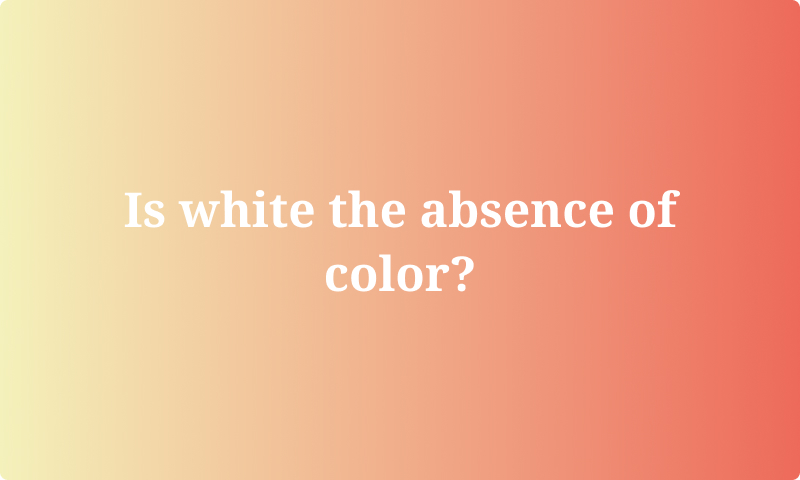
In this article, we'll figure out if white is the absence of color or not. We will apply basic color theory knowledge of how colors work to answer this question. In addition, we'll consider well-known color models like RGB and CMYK to see if different rules apply.
Let's start with the short answer and take a closer look at the details after that.
Is white the absence of color?
In color theory, white is the color of all wavelengths together. When you see a white object, all color wavelengths are reflected off of that object. When every color reflects from the object, there's no color left. Therefore, white is the absence of color in the object, while our eyes see all the reflected colors.
This is the short answer. There's more to it, of course. For example, we also have to consider the RGB and CMYK color models to see if there's a different answer there. But first, let's take a closer look at how our eyes see color.
How we see color
To determine whether or not white is the absence of color, we have to understand how we see color. And that starts with the sun.
The sun emits white light. If you break it down, that white light contains all the colors we see in nature spread across different wavelengths. You notice this when it rains while the sun is still out. What you then see is a rainbow of colors.

Take a look at the image above. When sunlight hits an object, it can either go through, reflect off, or get absorbed by that object. This happens for each color individually. Colors at a certain wavelength might get absorbed while another one gets reflected.
We perceive an object's color based on what gets reflected. If all colors get reflected, white sunlight is what our eyes will see. And because of that, we'll see a white object. Another reason why white is the absence of color in the object, but not in the light.
RGB
Up next is the RGB color model. This color model is widely used in digital design and monitors. While it uses the same color theory principles as discussed above, RGB is just slightly different.
RGB is an additive color model. That means you get a white color if you add colors together. Unlike sunlight, individual RGB screen LEDs only emit color at one wavelength. To get a white screen, you need to add all LEDs together.
So even though the color theory principle remains the same, in RGB, white is not the absence of color.
CMYK
The final color model we consider for this question is CMYK. You can use CMYK in print media, and it consists of cyan (C), magenta (M), and yellow (Y). The K stands for 'key' and is used to add black to your prints.
Unlike RGB, CMYK is a subtractive color model. You usually start with a white piece of paper and add layers of CMYK until you have the colors you want.
In nature, all colors together make white light. But in CMYK, all colors together make black. So from a CMYK perspective, white is the absence of color.
However, the color theory behind it is still the same. We see white paper because all color wavelengths reflect from the paper's surface. It's just the way you mix the colors that is different.
By the way, if you want to use white when printing on paper that isn't white, you can use a white spot color to have bright elements look more vibrant in the final print.
Is white a color?
We've discovered that white is the absence of color for the reflecting object, but not for how we see color. Because of that, we also have to ask ourselves if white is a color.
Solely from a practical perspective, white is a color. For example, if you look at the image below, you can see two objects. The first one is blue, but what would you call the second one?

An expert in color theory might say that the second object is colorless and that you see only the reflected wavelengths, but chances are that most people will say that the second object is white.
Because of that, you could say that white is still a color in everyday life, regardless of what color theory says.
Summary
Sunlight contains colors at all wavelengths. All these wavelengths together make white light. When that white light hits an object, we perceive that object's color as the colors that reflect from the object.
We see a white object when the object reflects color at all wavelengths. As a result, white is the absence of color for how we see the object, but not for the light itself, which contains all colors.
This is the color theory behind the question. However, if we take a more practical approach, we see that white can be considered a color if you ask people what color certain objects are.
